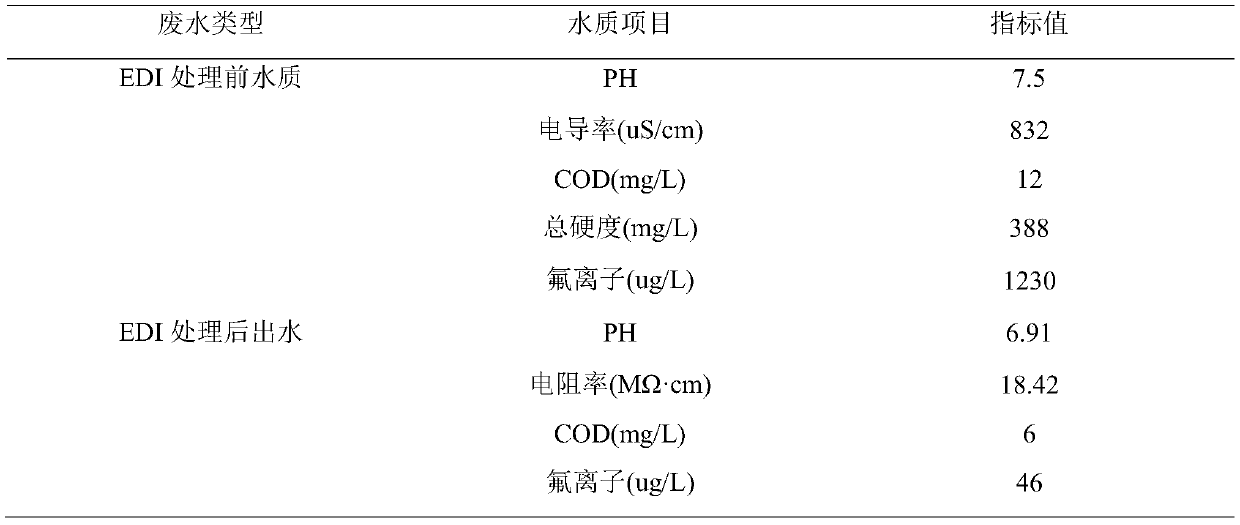Method for treating fluorine-containing reuse water
A treatment method and technology for water reuse, applied in multi-stage water treatment, water/sewage treatment, light water/sewage treatment, etc., can solve problems such as the inability to meet ultrapure water requirements, reduce fluorine content, and improve recycling. The effect of high efficiency and removal efficiency
- Summary
- Abstract
- Description
- Claims
- Application Information
AI Technical Summary
Problems solved by technology
Method used
Image
Examples
Embodiment 1
[0040] This embodiment takes fluorine-containing wastewater from the electronics industry, taking 2L of fluorine-containing wastewater from a microelectronics manufacturing plant, the raw water PH value is 2.84, the COD concentration is 86mg / L, and the fluoride ion concentration is 364mg / L as the object (the present invention uses direct ion selection The fluoride ion concentration in the water was measured by the sex electrode method, and the detection limit was 15.1 μg / L). The wastewater was treated by the treatment method of the present invention. The specific steps are as follows:
[0041] (1) Adjust the pH value of wastewater to 8-9, and introduce excess calcium hydroxide and calcium chloride solution into it to cause a chemical precipitation reaction to generate calcium fluoride.
[0042] (2) Flocculation and sedimentation. Step (1) Introduce coagulant PAC into the wastewater after chemical precipitation reaction to make small sediments generate larger particles, then adjust t...
Embodiment 2
[0058] This embodiment takes fluorine-containing wastewater from the electronics industry, taking 2L of fluorine-containing wastewater from a microelectronics manufacturing plant, the raw water PH value is 2.84, the COD concentration is 86mg / L, and the fluoride ion concentration is 364mg / L as the object (the present invention uses direct ion selection The fluoride ion concentration in the water was measured by the sex electrode method, and the detection limit was 15.1 μg / L). The wastewater was treated by the treatment method of the present invention. The specific steps are as follows:
[0059] (1) Adjust the pH value of wastewater to 8-9, and introduce excess calcium hydroxide and calcium chloride solution into it to cause a chemical precipitation reaction to generate calcium fluoride; based on the mass concentration of fluorine in the water, the hydroxide The dosage of calcium is The dosage of calcium chloride is
[0060] (2) Flocculation and sedimentation. Step (1) Introduce co...
Embodiment 3
[0075] This embodiment takes fluorine-containing wastewater from the electronics industry, taking 2L of fluorine-containing wastewater from a microelectronics manufacturing plant, the raw water PH value is 2.84, the COD concentration is 86mg / L, and the fluoride ion concentration is 364mg / L as the object (the present invention uses direct ion selection The fluoride ion concentration in the water was measured by the sex electrode method, and the detection limit was 15.1 μg / L). The wastewater was treated by the treatment method of the present invention. The specific steps are as follows:
[0076] (1) Adjust the pH value of wastewater to 8-9, and introduce excess calcium hydroxide and calcium chloride solution into it to cause a chemical precipitation reaction to generate calcium fluoride; based on the mass concentration of fluorine in the water, the hydroxide The dosage of calcium is The dosage of calcium chloride is
[0077] (2) Flocculation and sedimentation. Step (1) Introduce co...
PUM
 Login to View More
Login to View More Abstract
Description
Claims
Application Information
 Login to View More
Login to View More - R&D
- Intellectual Property
- Life Sciences
- Materials
- Tech Scout
- Unparalleled Data Quality
- Higher Quality Content
- 60% Fewer Hallucinations
Browse by: Latest US Patents, China's latest patents, Technical Efficacy Thesaurus, Application Domain, Technology Topic, Popular Technical Reports.
© 2025 PatSnap. All rights reserved.Legal|Privacy policy|Modern Slavery Act Transparency Statement|Sitemap|About US| Contact US: help@patsnap.com



